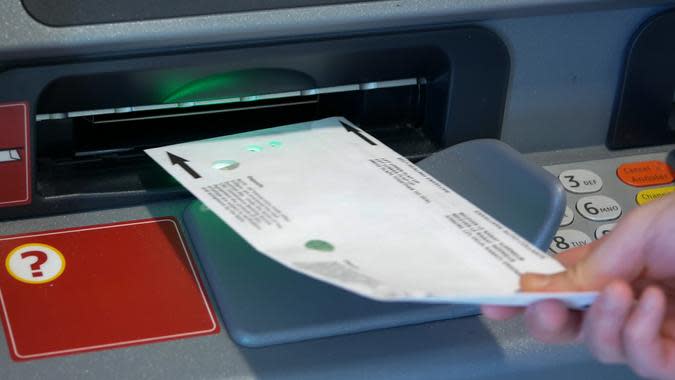17 Clever Ways To Save More for Retirement

Many workers, including those nearing retirement age, say they're not saving for a comfortable retirement. According to a 2022 study by Anytime Estimate, a real estate research firm, only 63% of Americans are saving for retirement. Of the remaining 37% who aren't actively saving, nearly four in 10 of them said they didn't have a dime in a retirement account.
Find Out: Can I Draw Social Security At 62 and Still Work Full Time?
Read More: 7 Surprisingly Easy Ways To Reach Your Retirement Goals
When it comes to squeezing more savings out of a paycheck, financial planners and retirement experts have some go-to strategies - some that you can start employing today. Check out these clever ways to save so you can retire rich.

Calculate What You Need To Save
Before you start saving, calculate how much you should be setting aside for the standard of living you desire.
Start by using a free online calculator, such as Vanguard's Retirement Income Calculator or the Fidelity myPlan Snapshot, to get a general idea of how much you need to save. Once you have an estimate, you might be more motivated to boost your savings.
Take Our Poll: Do You Think You Will Be Able To Retire at Age 65?

Automate Savings
Don't give yourself the option of whether to set aside money each month. Automate your savings so it's not a choice, said David Brooks Sr., president of Retire SMART. That means having contributions to a workplace retirement account, such as a 401k, automatically withdrawn from your paycheck or setting up automatic deposits into an individual account, such as an IRA, from your checking account.
With this approach, the money is deposited into savings before you have a chance to spend it. Plus, it will save you the time and hassle of having to transfer money to a retirement account each month on your own.

Get Your Employer's 401(k) Match
Would you say no to free money? Probably not. But plenty of employees do each year because they don't contribute enough to their 401(k) to get the full matching contribution from their employers.
In fact, 17.5 million people, or 12% of plan participants, miss out on receiving a full match by not saving enough, CNBC reported.
Check with your human resources department to find out if your employer offers a 401(k) match. It's most common for employers to contribute 50 cents for every $1 contributed by an employee to his or her 401(k) up to 6%, according to the 401(k)HelpCenter. For example, if you earn $40,000 a year and contribute just 3% of your salary, but your employer offers a 50-cent match up to 6%, you're missing out on $600 a year in free money.

Set Up Your Own Match
If your employer doesn't match your contributions to your workplace retirement plan, then set up your own match, said Zach Gieske, an operations analyst at Stable Value Investment Association, a nonprofit resource on retirement investing. Instead of purchasing a daily cup of coffee or a take-out lunch, he recommends putting that money into savings.
"It really helps get you in a saving frame of mind, and even has a side benefit of making you more aware of how seemingly little purchases can add up in your budget," Gieske said.

Boost Your Contribution Annually
Increasing the amount you stash away in savings by just 1% each year will significantly raise your balance over the long haul, Brooks said.
Here's an example from Fidelity: A 25-year-old earning $40,000 a year who contributes just 1% more of his salary each year (or $33 more each month) until age 67 would have $3,870 of additional yearly income in retirement, assuming a 7% rate of return and a 1.5% annual pay raise.

Stash Your Pay Raise in a Retirement Account
People don't often increase retirement contributions after getting a raise or bonus, but why not? Since workers are already accustomed to living on their existing salary, they won't notice money that they never had before is missing.

Put Your Tax Refund in a Roth IRA
Tax refunds might seem like you're getting free money, which increases your desire to spend it. But keep in mind that it's your money that the IRS has collected interest-free. You can put that refund to work for you by depositing it in a Roth IRA.
You can contribute up to $6,000 in a Roth IRA, and another $1,000 for a maximum contribution of $7,000 if you're 50 or older. You won't get a tax deduction for your contribution, but withdrawals are tax-free in retirement.

Adjust Your Withholding Allowances
Getting a big tax refund from Uncle Sam means that the government held on to money that you could have used to pay bills or invest. So, if you usually get a fat refund, consider adjusting your payroll withholding allowances so you can keep more money in your paycheck each month. The higher number of allowances you claim up to a point, the lower the tax refund. File a new W-4 form with your employer to claim more allowances. Use the IRS.gov withholding calculator to figure out how many allowances to claim. If you received a refund of about $3,000, you could get an extra $250 each month by adjusting your withholding. Then deposit that money into a retirement account.

Make Catch-Up Contributions
You can kick retirement savings into high gear once you turn 50 because the IRS tax code lets you make catch-up contributions.
You can add an extra $6,500 to a 401(k), 403(b) or 457 plan for the 2022 tax year. You can boost traditional and Roth IRA contributions by $1,000 for a total maximum contribution of $7,000 per year.

Start a Self-Employed Retirement Account
Being self-employed doesn't mean your retirement savings options are limited. Self-employed individuals can contribute 25% of their income, up to a maximum of $61,000 for tax year 2022, to a Simplified Employee Pension IRA (SEP IRA) or to a 401(k) that you set up with an investment firm such as Fidelity or Charles Schwab.
"One of the most overlooked ways to save for retirement is through a SEP IRA," said Tom Balcom, a certified financial planner in Florida and founder of 1650 Wealth Management.

Save in an HSA
A Health Savings Account (HSA) is meant to help people with high-deductible health insurance policies set aside money to cover out-of-pocket medical costs. But it also can be part of a retirement savings plan.
"When in retirement, this account can continue to be used to pay for medical expenses, preserving more of the traditional retirement savings and income," said Christian Sees, owner of Integrus Financial, a financial services company.
Contributions to an HSA are tax-deductible or made with pre-tax dollars. The funds grow tax-deferred, and withdrawals for qualified medical expenses are tax-free.

Downsize, Then Retire
Don't wait until you retire to downsize to a smaller home. The sooner you cut your housing expenses by downsizing, the more money you'll have to set aside for retirement, and the more time that money has to grow.
If you downsize from a $250,000 house to a house that costs $150,000, for example, and factor out the costs of selling and moving (10 percent of the selling price), you'll have $75,000 that can be added to savings, according to a report called Using Your House for Income in Retirement by the Center for Retirement Research at Boston College.
Consider this: If you withdraw 4% of that $75,000 annually, according to the report's calculations, you can increase your yearly income in retirement by $3,000. If you downsize even earlier, say in your 40s, and invest that $75,000 in a portfolio with a mix of stocks and bonds with a 6.5% annual rate of return, it could grow to nearly $250,000 over 20 years.

Save Spare Change
Tossing spare change in a jar might seem like an old-fashioned approach to saving, but you'd be surprised how quickly your nickels, dimes and quarters can add up. "Cash it in twice a year and put it into a savings account that you never touch," said John Graves, author of "The 7% Solution: You Can Afford a Comfortable Retirement."
You can take a slightly more sophisticated approach by letting your bank do this for you. For example, Bank of America's Keep the Change savings program will round up debit card purchases to the nearest dollar and transfer the difference to a savings account

Use an App or Online Tool
Mobile apps make it easy to automate your savings if you lack the discipline to do it on your own. For example, the Digit app analyzes your spending patterns and will move a little bit of money that it deems disposable into your savings every day. It claims that it has helped its users to save more than $7 billion since 2015. For additional savings, move the money into an interest-bearing savings account.
Or, you can link the Acorns app to your debit or credit card, and it will round up your purchases to the nearest dollar and invest the difference into a diversified portfolio of index funds.

Invest What You Save
People often talk about how much they saved on groceries, clothes, gas and more. "But do they really save it?" said John Sweeney, formerly the executive vice president of retirement and investing strategies at Fidelity Investments who now is the COO at Osprey Funds in Boston. "If you 'saved' money at the pump or the grocery store, then why not literally save it?"
Keep track of how much you saved by using coupons or buying items on sale and put that money into a savings or retirement account. "You'll see how quickly $10 to $20 here and there can add up," Sweeney said.

Claim Lost Money and Invest It
States hold billions of dollars in unclaimed assets, from money in inactive savings accounts to uncashed payroll checks, unclaimed pensions and tax refunds, insurance payments and more. The federal government also holds onto lost money. Some of it might be yours.
Visit MissingMoney.com to search its database of unclaimed property records at participating states. Or you can search state by state with the National Association of Unclaimed Property Administrators. You can use the Where's My Refund tool at IRS.gov to see if you're owed a tax refund. And you can search for unclaimed savings bonds using the instructions on the Treasury Hunt website. Deposit any money you find into your retirement savings.

Save for Your Spouse
Typically, you must have earned income to contribute to an IRA. If you work but your spouse does not, however, you can make contributions for your partner in a spousal IRA.
You must be married and file a joint tax return and can contribute up to $6,000 a year ($7,000 if you're 50 or older). You can choose either a traditional IRA or a Roth IRA if your income falls below certain levels. This is a solid approach to creating a retirement nest egg for a non-working spouse or stay-at-home parent.
More From GOBankingRates
Zelle Facebook Marketplace Scam: How To Recognize and Avoid This Scam
Looking To Diversify in a Bear Market? Consider These Alternative Investments
Cameron Huddleston contributed to the reporting for this article.
This article originally appeared on GOBankingRates.com: 17 Clever Ways To Save More for Retirement

 Yahoo Finance
Yahoo Finance 